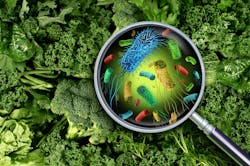Photonic sensor detects trace amounts of pesticides in under 30 minutes
Recognizing that monitoring fruit and vegetables for microscopic pesticides and harmful bacteria can take days of sending small batches off to laboratories for testing and analysis, a team of researchers in Europe is developing a new detector that can spot minute traces of these poisonous elements with photonics. This new ultrasensitive detector harnesses light particles to spot the tiniest traces of pesticide or bacteria in minutes, which is 50–100X faster than existing technologies.
Currently being developed by the GRACED project consortium, the photonic detector will allow workers to check for pesticides or bacteria by monitoring dozens more samples of fruits and vegetables than are currently performed. Called a plasmo-photonic bimodal multiplexing sensor, the system can spot bacteria or pesticides label-free, without having to use chemicals or dyes as a marker—and in less than 30 minutes.
Typically, safety checks on fruit and vegetables are made in random batches then sent to a laboratory, a process that can take 2–3 days to get a result. Due to time and costs, these checks cannot be performed in critical parts of the value chain, such as supermarkets and restaurants.
To produce an unequivocal bacteria or pesticide detection, the plasmo-photonic bimodal multiplexing sensor system works by looking at the ‘binding’ of the contaminant to the sensor surface, producing a new unique signal when a harmful constituent is present. Since the receptors on the sensor surface are specifically ‘tuned’ to a particular bacteria or chemical, only the analytes of interest are captured along the sensor.
Light traveling in the sensor generates a fully exposed evanescent field over the sensor surface—here, receptors can recognize the contaminants when a sample passes through. This recognition event changes the speed of the laser light and therefore the interference pattern at the output. This change can be measured and determined precisely against a set of existing values, and could give an instant diagnosis for a contaminant expected at the picomolar-to-attomolar range without any need for amplification.
The GRACED team sees the applications as being extremely useful to several next-generation food production alternatives. “Vertical or urban farms are like a bit like a laboratory where everything is conducted in controlled rooms. Controlling the water quality is very important to the success of these types of farms, and if this process is automated, it is even better,” explains GRACED project coordinator Alessandro Giusti. “Some urban farms are using ‘gray water’—sink water used for irrigation—where the risk of contamination is possible. So, a solution like ours will be highly complementary to futuristic food production.”
Concluding in 2024, the GRACED project will conduct future trials in France, Italy, and Hungary, covering different types of production systems such as conventional open-air farming, novel urban farming, short agroecological value chain, and semiautomatic farming. The three-and-a-a-half-year project received a grant of €4,989,480 (over $5.7 million) from Horizon 2020 under the Research and Innovation action funding scheme.
